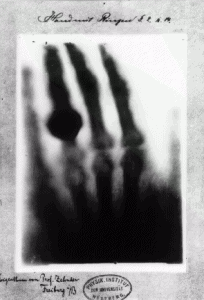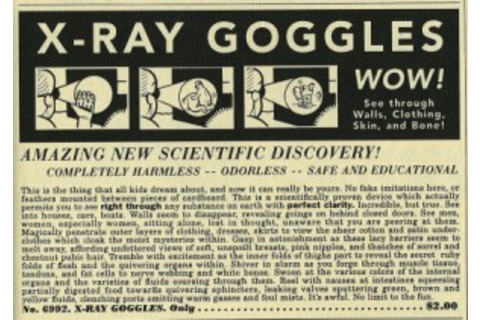Sometimes the Nobel prize in physics requires a fair bit of decoding for the non-expert (such as the 2013 award for the theory behind the Higgs boson, or the award the year before "for ground-breaking experimental methods that enable measuring and manipulation of individual quantum systems"). There was little room for confusion about the 2014 prize, which recognized the inventors of the blue LED, the crucial technology for energy-efficient indoor LED lighting. But in terms of public acclaim, nothing compares to the very first Nobel prize in physics, awarded in 1901 for work that had already been a source of excitement, scandal, and quackery for 5 years.

Hand of Anna Bertha Röntgen, the first medical X-ray ever made. The story goes back to November of 1895, when Wilhelm Röntgen was experimenting with cathode-ray tubes--the predecessors of the old vacuum tube television sets. During his tests, he noticed that when he powered up the tubes, they caused a fluorescent screen in his lab to light up. On November 8 he studied the effect in detail and confirmed that something from the tubes was making his screen light up even if the tube was completely sealed in light-proof cardboard. He suspected, correctly, that the tube was producing some novel kind of invisible ray. Further experiments showed that these rays could travel across the room, penetrate wood and thin pieces of metal, and would create an image on unexposed photographic film. Since Röntgen had no idea what the rays were, he called them "X-rays" (X for unknown), a name that stuck. Röntgen fully realized the magnitude of his discovery. He hastily wrote up his results and, by the end of December, had a paper accepted in Proceedings of the Würzburg Physical-Medical Society. Not bad--less than 8 weeks from discovery to an accepted paper. Out of curiosity, Röntgen took an X-ray image of his wife's hand. The sight of Anna Bertha's exposed bones (contrasted spookily with her wedding ring) so shocked him that he reportedly exclaimed, "I have seen my death!" It also sparked an idea about how to get his colleagues to understand the tremendous significance of his discovery. On January 1, 1896, he mailed copies of a preprint of his article to a number of friends and colleagues, along with nine sample X-rays he had taken--notably, including the one of his wife's hands. Then the story leaked to German newspapers and all hell broke loose... There was great interest, and a dose of skepticism, in the scientific community. The public reaction, on the other hand, was immediate and downright overwhelming. Everyone wanted to see an X-ray. Genteel women worried about X-ray Peeping Toms. A British garment maker promoted "X-ray proof underclothing." the better to preserve privacy in a world where the old rules no longer applied. Thinking along similar lines, an assemblyman from New Jersey proposed legislation banning X-ray opera glasses. The whole incident is well-described here on the Nobel prize web site. It is easy to scoff at such naivete now, but at a time when science had produced something astonishingly new and incomprehensible, it didn't seem so absurd that dress-penetrating "X-ray specs" might actually be feasible. Let's face it: The goal never really died for some adolescent boys.

For a moment it seemed possible... In short order, the real utility of X-rays became clear--for medicine, for engineering, and later for chemistry as well. X-ray crystallography was crucial for deducing the structure of DNA, for instance. Although X-rays remained rooted in the popular culture, they penetrated more and more areas of science. Astronomy was a latecomer, because Earth's atmosphere effectively blots out X-rays from space, but in 1948, rocket-borne instruments detected X-ray emissions from the sun. By the 1970s, a series of satellite telescopes showed that the universe is awash in X-rays. Some of the sources seem to be disks of hot gas swirling around dense, compact objects. In extreme cases those objects seem to be black holes, and in the most extreme cases those black holes appear to be monsters that are billions of times as massive as the sun, lumbering at the centers of giant galaxies. X-rays highlight quasars, supernovas, and other locations of immense energy. In other words, X-rays point to some of the most exotic objects in the universe, far from the immediacy of Röntgen's original research, which got this whole physics-Nobel-prize thing going in the first place. But the rays themselves are the exact same ones that passed through Anna Bertha's hand and that still remind us, so powerfully and undeniably, we are just animated piles of bones.
Follow me on Twitter: @coreyspowell













